
06 Sep Essential Applications of ACP Aluminium Composite Panels in Modern Architecture
Table of Contents
ACP aluminium composite panels are essential in building design today. Widely used in modern architecture, these acp aluminium composite panel products are lightweight, durable, and versatile. Architects rely on acp aluminium composite panel materials to enhance both the interior and exterior aesthetics of buildings. In fact, over 44% of architecture firms worldwide incorporate acp aluminium composite panel solutions for building facades.
Region/Country | ACP Usage in Building & Construction (%) | Specific Usage in Architectural Projects (%) | Notes |
|---|---|---|---|
Global | 84% | Over 44% | Used most in new buildings |
China | 28% | 78% | Used extensively in tall buildings |
India | 24% | 73% | Common in homes and offices |
United States | 19% | 51% | Emphasis on fire-safe acp aluminium composite panel options |
Germany | 11% | 56% | Applied in public buildings |
UAE | 8% | 62% | Featured in large building projects |
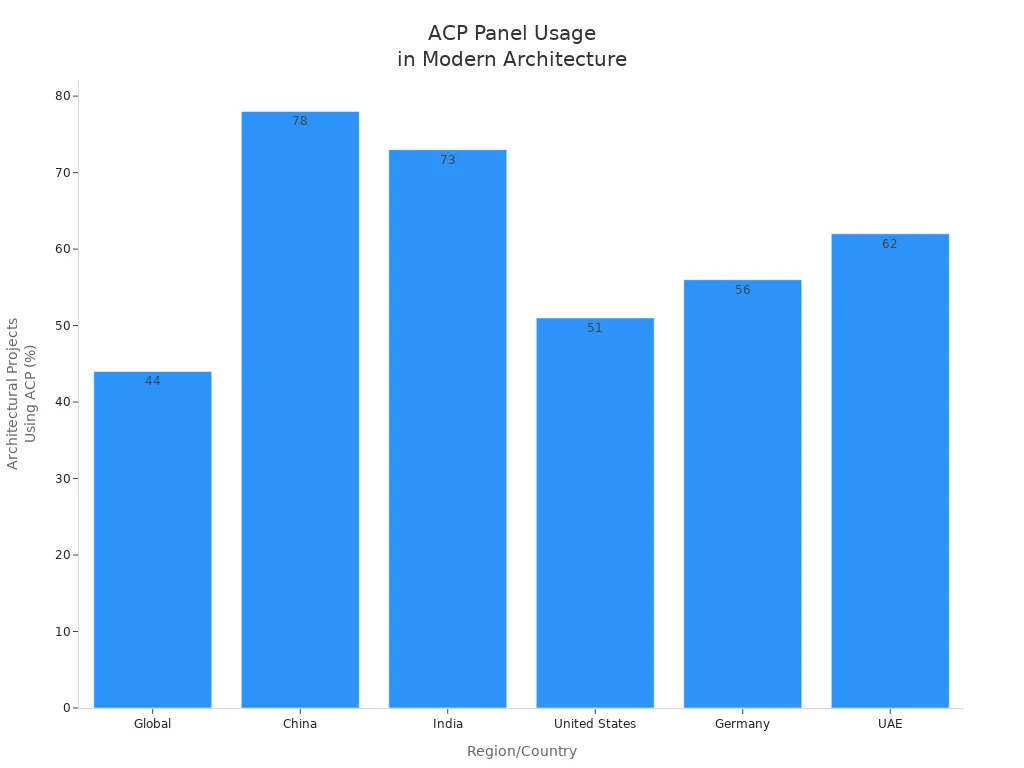
Architects prefer acp aluminium composite panel products because of their long-lasting durability and excellent resistance to harsh weather conditions. These panels support a wide range of design possibilities, offering cost savings, environmental benefits, and protection against noise and weather. Thanks to these advantages, many professionals choose acp aluminium composite panel materials for innovative and resilient building designs.
Key Takeaways
ACP aluminium composite panels are light and strong. They can last 30 to 50 years. This makes them great for new building designs.
These panels give many choices for design. They come in different finishes and shapes. Architects use them to make buildings look nice. They also help save energy.
ACP panels make buildings safer. Some types can resist fire. They also protect well from bad weather.
Using ACP panels helps save energy. They keep heat out or in. This lowers the cost for cooling and heating.
ACP panels are good for green building. They can be recycled and are eco-friendly. They help buildings get sustainability certifications.
ACP Aluminium Composite Panel Overview
Structure and Types
ACP aluminium composite panel products have a special build. Each panel has two thin aluminum sheets on a core. The core changes how the panel works. Most acp sheets have a polyethylene (PE) core. This makes them light and easy to bend. Some panels have a mineral-filled core. These are better at stopping fires. Others use a honeycomb core for more strength. Metal composite panels have metal inside for tough jobs.
Panel Type | Core Composition | Strength | Fire Resistance | Typical Applications |
|---|---|---|---|---|
Standard ACP | Polyethylene (PE) core | Strong | Basic | Walls, signs, interior spaces |
Fire-Rated ACP | Mineral-filled core | Strong | Very good | Tall buildings, hospitals, schools |
Honeycomb Panel | Honeycomb core | Very strong | Good | Large walls, ceilings |
Metal Composite | Bonded metals as core | Very strong | Good | Heavy-duty applications, facades |
Manufacturers make panels with many finishes. Glossy, wooden, and mirrored acp sheets give lots of design options. PVDF-coated aluminum composite panels last longer outside. These coatings help keep color and protect from weather.
Key Features
Aluminum composite panels are very light. This makes acp sheets simple to move and put up. The panels are strong and last a long time. They can last 30 to 50 years on buildings. Aluminum does not rust, so it stays strong. ACP aluminium composite panel products can handle bad weather, sun, and water. Cleaning and good setup help them work well.
Fire-resistant acp sheets have mineral-filled cores. These panels follow safety rules and lower fire risks in tall places. ACP aluminium composite panel materials are easy to shape and use. Architects use them for curves, bright colors, and special shapes. The panels block sound and heat, so they work inside and outside.
Tip: ACP sheets can be recycled, so they are good for green buildings.
Applications in Modern Architecture
 Building Facades
Building Facades
ACP sheets are a top pick for building facades today. Architects use them to make buildings look smooth and modern. In new business buildings, about 30% of the outside uses ACP panels. The rest is made of glass. This mix gives buildings a fresh style and helps them work better. ACP cladding keeps buildings safe from bad weather. It also helps the outside stay nice for a long time. The panels do not rust or lose color, so they last. Using ACP panels on facades also helps save energy. They stop too much heat from getting in and help lower cooling bills.
Note: Some ACP sheets can reflect up to 70% of the sun’s rays. This helps buildings stay cool and saves energy.
Ventilated Facades
Ventilated facades use ACP sheets to make a space between the wall and the panels. This space lets air move and helps keep the building cool inside. ACP panels are light and strong, so they are easy to put up and take care of. Their painted surfaces do not rust and can handle the sun. This makes them last longer and stand up to weather. Some ACP panels, like Buildbond, give extra protection from the sun. These facades also help save energy by cutting down on heating and cooling. Ventilated facades with ACP need little care and help buildings look new.
ACP panels are light and strong, so they are easy to install.
Painted surfaces stop rust and work in all kinds of weather.
UV-resistant ACP sheets keep ventilated facades safe from the sun.
Ventilated systems help save energy and need less upkeep.
Curtain Walls
Curtain walls often use ACP panels for style and safety. ACP sheets with special cores meet fire safety rules in big buildings. Their light weight means the building does not have to hold as much weight. This makes putting them up faster. Architects can use ACP cladding to make curves and cool shapes. Prefab and special fixing help cut and place panels just right. The Jax Studio facade shows how ACP panels can look good, be strong, and not cost too much. Curtain walls with ACP panels also help keep heat and cold out, which saves money.
Fire-safe ACP panels meet the rules for curtain walls.
Light ACP sheets make putting them up quick and easy.
ACP panels can be shaped for creative designs.
Curtain walls with ACP help save energy and are good for the planet.
Sunshades and Louvers
Sunshades and louvers made from ACP sheets give shade and stop too much heat. ACP panels are tough and can handle bad weather, rust, and the sun. This makes them great for outside use. Taking care of ACP sunshades and louvers is easy. You mostly just need to clean them to keep them bright and smooth. Good planning helps these features last and look nice. ACP cladding in sunshades and louvers helps control sunlight. It also saves energy and gives buildings a modern look.
ACP panels stand up to weather, rust, and the sun, so they need little care.
Cleaning and small fixes keep sunshades and louvers looking good.
ACP sheets help control sunlight and save energy.
Strong ACP cladding makes sunshades and louvers a smart choice outside.
Canopies and Awnings
Canopies and awnings in business buildings often use ACP panels because they last and stand up to weather. ACP sheets can handle the sun, rain, and changes in temperature. They keep looking good over time. Their smooth surfaces stop dirt from sticking and make cleaning simple. ACP panels come in many colors and styles, so architects can make cool and modern canopies. The light weight of ACP sheets means the building does not have to hold as much weight. This makes putting them up easier. Flexible ACP cladding lets architects make fun shapes and features in canopies and awnings. This makes buildings look better and gives good cover.
ACP panels stand up to the sun, rain, and heat for a long time.
Smooth surfaces make cleaning easy and stop dirt from building up.
ACP sheets give lots of choices for modern canopies and awnings.
Light ACP cladding makes putting them up easy and helps with cool designs.
Strong ACP panels help canopies and awnings keep working and looking good.
Tip: Using outside-grade ACP sheets for canopies and awnings helps them last longer and keeps costs down.
Interior ACP Panel Applications
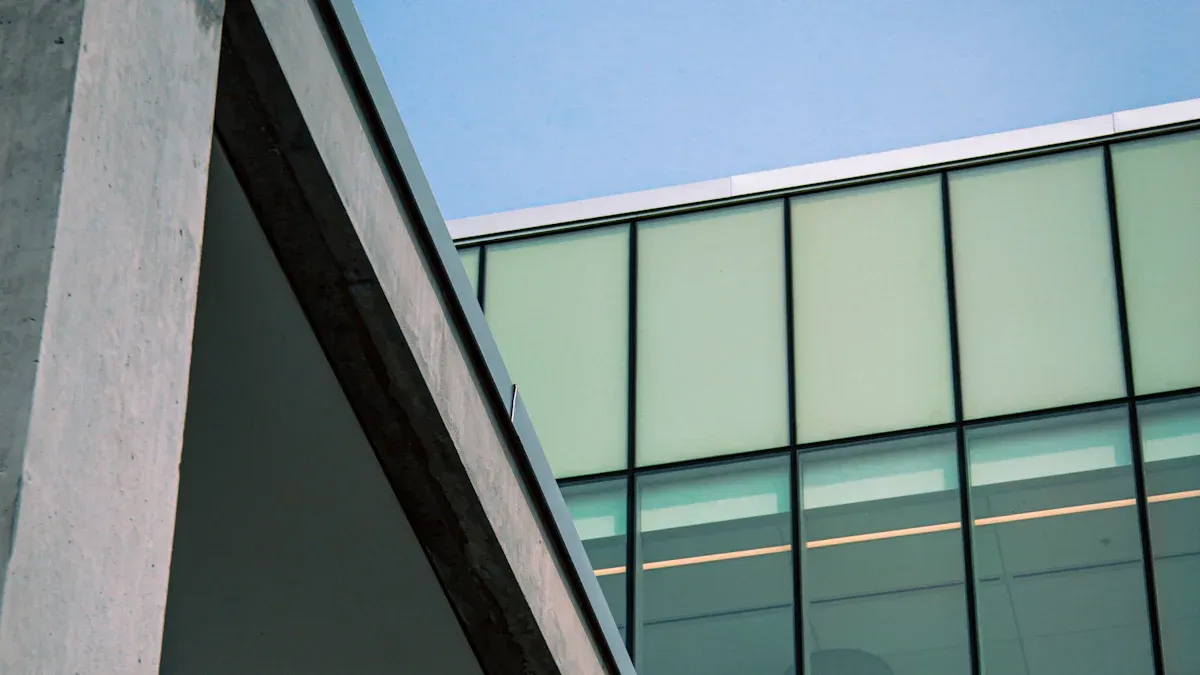
Wall Cladding
Aluminum composite panels are a popular pick for wall cladding. Designers use acp sheets to make walls look smooth and neat. These panels come in many colors and textures. Some people like wooden or shiny finishes for a fancy look. Wooden finishes make rooms feel warm and cozy. Glossy finishes bounce light and make rooms seem bigger.
Finish Type | Impact on Perceived Luxury | Typical Applications | Performance & Practical Benefits |
|---|---|---|---|
Feels warm and natural. Looks like real wood. Makes spaces comfy and fancy. | Homes, hotels, schools | Light, stands up to weather, easy to care for, good for the planet. | |
Glossy ACP | Looks bright and modern. Shiny finish makes rooms feel open. | Offices, stores, airports | Simple to clean, strong, saves energy. |
Wall cladding with these panels keeps walls safe from scratches and stains. The panels are simple to clean and do not need much care. Many architects pick acp because it saves time and money to install. These panels are lighter than stone or wood, so they are easier to use.
Tip: Wooden finish acp panels look so real that most people cannot tell them apart from real wood.
Ceilings
Ceilings made with aluminum composite panels look modern and nice. ACP panels are light, so workers can put them up fast and safely. This means less work and lower costs than stone or wood.
Material | Initial Cost | Long-Term Expenses |
|---|---|---|
ACP Panels | Costs about the same as fancy stone, more than vinyl | Needs little care, so saves money later |
Natural Stone | Costs more at first | Needs more care over time |
Vinyl | Cheaper at first | Needs some care later |
Wood | Costs a bit at first | Needs sealing or painting |
Aluminum composite panels let people make cool ceiling designs. Installers can cut them into shapes and patterns. Glossy ceilings reflect light and make rooms brighter. Wooden ceilings add warmth to living rooms, bedrooms, and offices. ACP ceilings do not get damaged by water, so they are good for kitchens and bathrooms.
Partitions and Room Dividers
Partitions made from aluminum composite panels split big rooms into smaller spaces. ACP panels are strong but light, so they are easy to move and put up. Offices and schools use acp partitions to make quiet places for meetings or study.
ACP panels block up to 85% of noise, so rooms are quieter.
They give privacy but still let people work together.
Made from recycled stuff, they are good for the earth and easy to build.
You can change the layout for different designs.
The inside of the panels helps stop sound, making rooms less noisy. ACP partitions come in lots of colors and finishes to match any style. Wooden finishes feel comfy and fancy, while glossy ones look modern.
Furniture and Cabinetry
Aluminum composite panels are used for furniture and cabinets too. ACP sheets make strong, light cabinets, shelves, and counters. These panels do not get ruined by water or stains, so they are great for kitchens and bathrooms. Designers pick wooden finishes for a classic look. Glossy finishes make offices and stores look sleek and new.
ACP panels are easy to cut and shape for custom furniture.
The panels last a long time and need little care.
Wooden and glossy finishes make furniture look better.
Many people like aluminum composite panels for furniture because they last longer than wood and do not need painting.
Decorative Elements
Decorative pieces made from aluminum composite panels make rooms look nice and work well. Designers use acp sheets for accent walls, column covers, and art. Wooden finishes add warmth and style to living spaces. Glossy finishes stand out in lobbies, stores, and fun places.
ACP panels are used for kitchen backsplashes because they do not get wet and are easy to clean.
False ceilings made from acp can be shaped for a cool look.
Accent walls and column covers with acp make rooms more interesting.
Aluminum composite panels can be used in many ways for decoration. They are strong, light, and come in many finishes, so they are a top pick for modern rooms.
Note: Using ACP panels inside shows how useful and stylish aluminum composite panels can be.
Applications of Aluminum Composite Panels in Signage
 Exterior Signage
Exterior Signage
Aluminum composite panels are important for outdoor signs. Many companies pick these panels because they last and look nice. The panels can handle tough weather like rain, snow, and strong sun. Their special surfaces stop rust, so signs stay bright for years. Installers can cut and shape the panels easily. This helps make cool signs for different brands. The panels are light, so they do not stress buildings. This makes putting up signs quick and safe.
Designers use aluminum composite panels for big signs, billboards, and building names. The panels come in many colors and finishes like shiny, flat, or metallic. These choices help businesses match their signs to their brand. The smooth panels work well for clear pictures and printing. Some signs use lights to stand out at night. The panels do not fade, crack, or peel, so outdoor signs look new for many years.
Tip: Clean outdoor signs often to keep them looking fresh and neat.
Interior Signage
Stores, malls, and offices use aluminum composite panels for indoor signs. These panels are strong and look good. Their layered build makes them light but tough. Signs made from these panels do not scratch, dent, or stain easily. This helps them look nice even in busy places.
Aluminum composite panels let designers make creative signs. Designers can cut, bend, or shape the panels in many ways. The panels show clear pictures and logos. Many stores pick finishes like wood, mirror, or sparkle to match their style. The panels work well with lights, so signs are easy to see.
Indoor signs made from aluminum composite panels need little care. The smooth surface stops dirt from sticking, so cleaning is easy. Stores can change their signs often because the panels are simple to swap. These features make aluminum composite panels a great pick for modern signs.
Specialized ACP Panel Applications
Acoustic Panels
Many architects use aluminum composite panels to help control sound. These panels make rooms quieter by blocking noise. Schools, offices, and hospitals need quiet places. The panels have layers that stop sound from passing through. This makes them a good pick for acoustic panels. Designers can pick finishes and colors to match the room. The panels are light, so workers can put them up fast. They last a long time and do not need much care.
Note: Acoustic panels made from aluminum composite panels help make rooms calm and good for work.
Green Building Solutions
Aluminum composite panels are important in green building projects. Builders use these panels because they help the planet. Many panels can be recycled and use less energy to make. They do not give off bad gases, so air inside stays clean. Some panels have special cores that lower fire risks and follow safety rules. These things help buildings get green awards like LEED.
Recyclable panels help keep materials in use.
No bad VOCs means better air inside.
Panels help builders get LEED and other green awards.
Fire safety and following rules make panels even better.
Aluminum composite panels also keep heat in or out. This saves energy by keeping buildings warm or cool. Builders who care about the earth often pick these panels for their jobs.
Modular Construction
Modular construction uses parts made somewhere else and put together at the site. Aluminum composite panels work well for this way of building. The panels are strong and can handle bad weather. They are light, so moving and putting them up is easy. This saves time and money for builders. Prefab panels help finish buildings faster, even if there are problems with weather or workers.
Panels last a long time and do not need much care.
Fireproof cores make buildings safer for people.
Recyclable panels help the environment.
Good insulation keeps buildings comfy and saves energy.
Light panels mean builders do not need big machines.
Aluminum composite panels help modular buildings look new and stay strong. Their low cost and flexibility make them a smart pick for many jobs.
Design Trends and Sustainability
 Modern Aesthetics
Modern Aesthetics
Architects use aluminum composite panels to make buildings look bold. These panels come in many colors and textures. Some look like wood or stone. Others have shiny metal surfaces. Designers pick 3D textured panels to make walls pop. Perforated panels help with decoration and let air move. Metallic finishes like gold and bronze add luxury. Weather-resistant panels with natural looks blend inside and outside spaces. This helps buildings feel close to nature.
Note: Aluminum composite panels let architects make cool shapes and patterns that are hard with other materials.
Energy Efficiency
Aluminum composite panels help buildings use less energy. Their layers keep heat out in summer and warmth in winter. The shiny surface sends sunlight away, so rooms stay cool. This means less air conditioning is needed. The panels block wind, rain, and UV rays. This keeps rooms comfy inside. Because they are light, builders use less steel and concrete. This saves resources. The panels last long and need little care. They help cut down on waste and support green building.
Shiny coatings help keep cities cooler by lowering heat.
Weather resistance keeps rooms comfy and saves energy.
Aluminum can be recycled, which is good for the planet.
Customization and Printing
New technology lets designers change aluminum composite panels in many ways. Digital printing puts patterns, logos, or photos on panels. AI tools help make special textures and colors for each job. Some panels have coatings that clean themselves. Architects can pick from many types. There are 3D sheets for fun walls, wood-look panels for warmth, or mirrored panels for a modern style.
Custom Feature | Common Use | |
|---|---|---|
3D ACP Sheets | Custom shapes and patterns | Interior decoration, facades |
Digital Print ACP Sheets | UV-resistant, bright graphics | Signs, cladding, feature walls |
Wooden Finish Panels | Real wood grain look | Warm, natural interiors |
Mirrored Panels | Shiny surface | Modern, eye-catching designs |
Tip: Custom panels are great for branding, art, and cool building designs.
Aluminum composite panels are important in modern buildings. Architects use them because they are strong and light. These panels help make creative building designs. ACP panels save energy and last a long time. They also follow fire safety rules. You can use ACP panels outside or inside buildings. They look good in homes, malls, and offices. Many projects show how useful ACP panels are.
Feature | ACP Panels | Other Materials |
|---|---|---|
High | Varies | |
Design Flexibility | Very High | Lower |
Maintenance | Low | Higher |
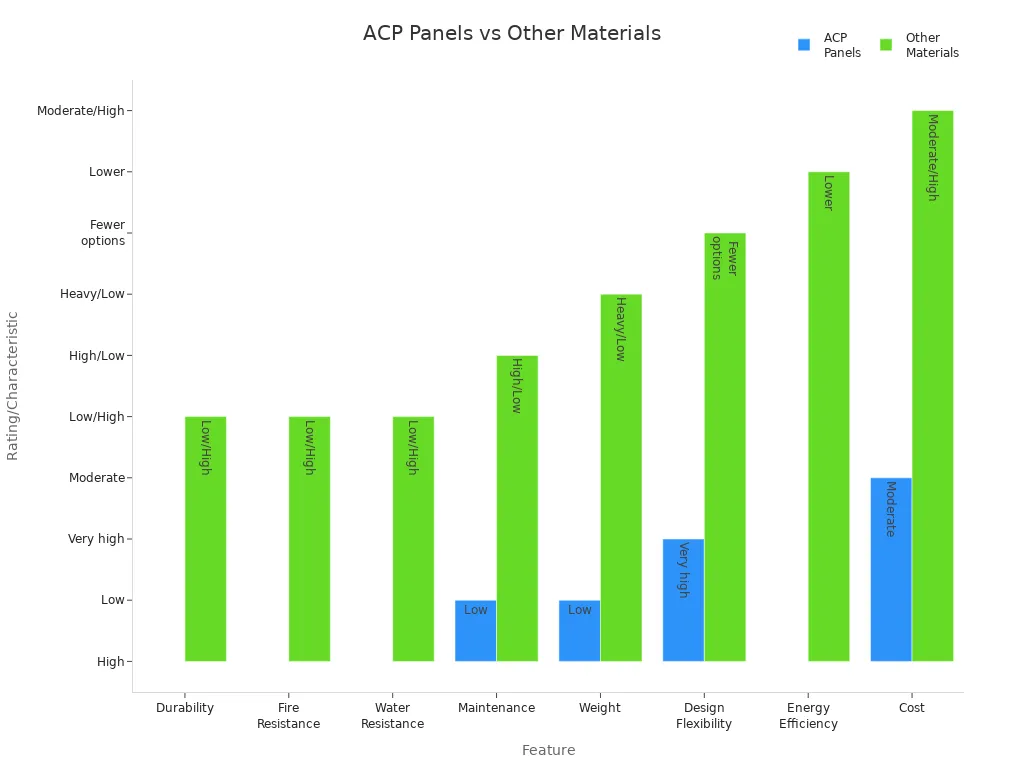
ACP panels are a smart pick for modern buildings. They help make buildings look nice and use less energy. People choose ACP panels for safe, strong, and green building solutions.
FAQ
What are ACP aluminum composite panels made of?
ACP panels have two thin aluminum sheets. These sheets are stuck to a core that is not aluminum. The core can be polyethylene, mineral-filled, or honeycomb. This build makes the panels strong. They are light and easy to bend.
How long do ACP panels last on buildings?
Most ACP panels last from 30 to 50 years. They do not rust or fade. They stand up to bad weather. Cleaning them often helps them stay nice for many years.
Are ACP panels safe for fire protection?
Fire-rated ACP panels have mineral-filled cores. These panels follow tough safety rules. Architects use them in tall buildings, hospitals, and schools.
Can ACP panels be recycled?
Yes, ACP panels can be recycled. Makers can reuse the aluminum and the core. This helps make ACP panels good for green building projects.
Where can designers use ACP panels indoors?
Wall cladding
Ceilings
Partitions
Furniture
Decorative elements
Designers use ACP panels in lots of places. They are light, strong, and come in many styles.

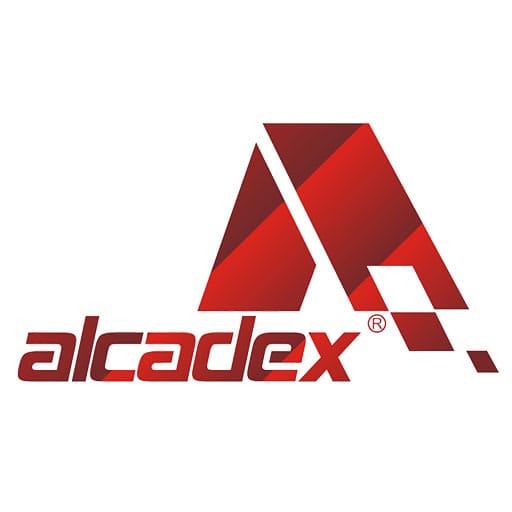

 Building Facades
Building Facades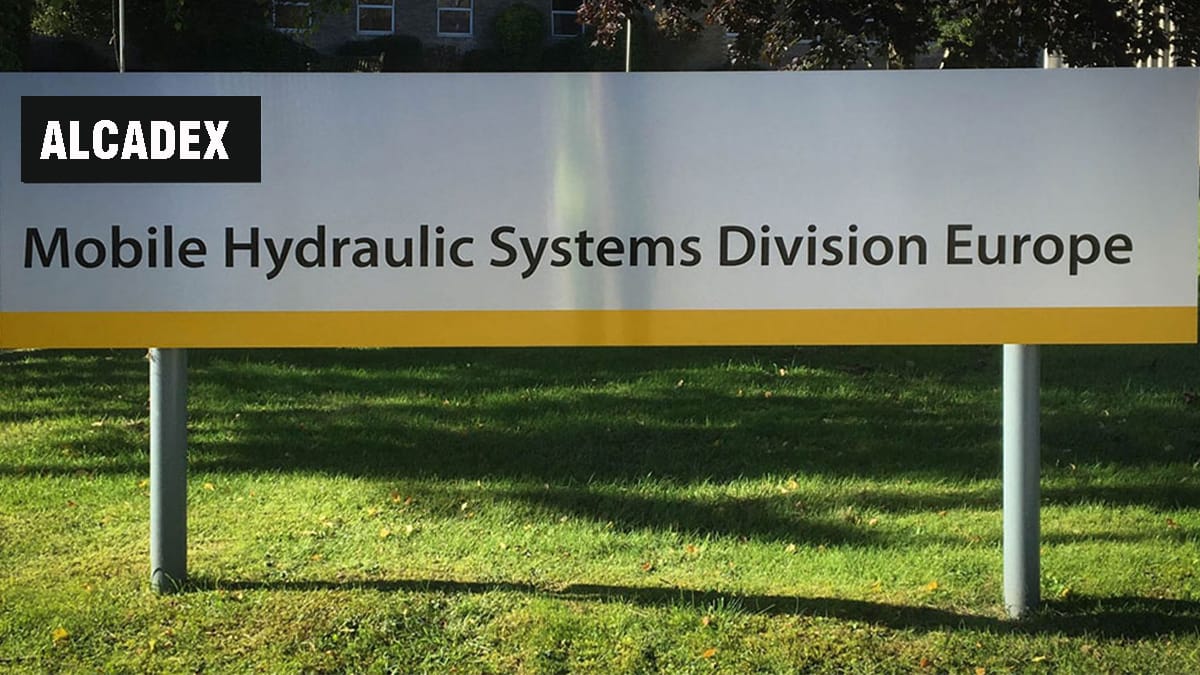 Exterior Signage
Exterior Signage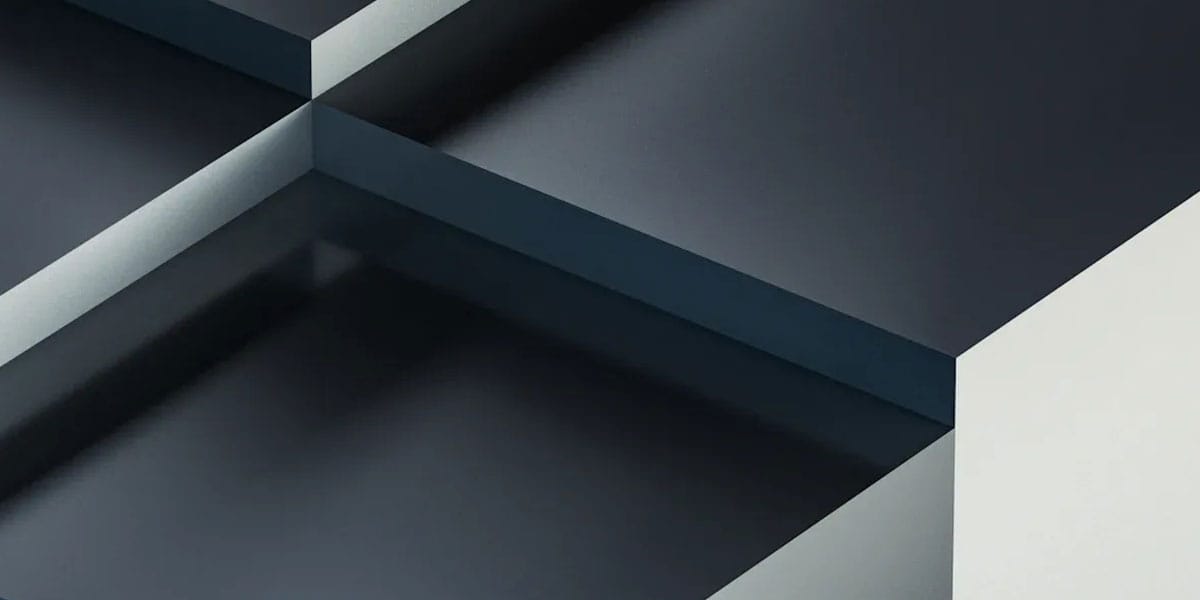 Modern Aesthetics
Modern Aesthetics